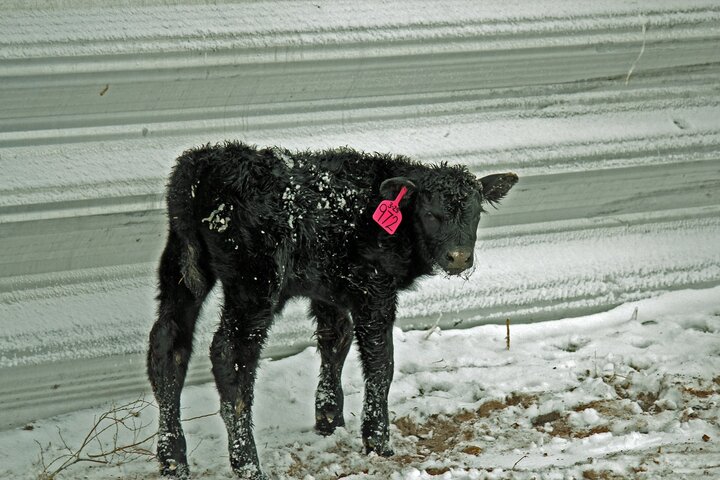Shelter for livestock during the winter months can influence the success of calving and a livestock operation. Protection from the wind and snow is not always readily available from natural topography or living windbreaks such as tree lines or shrub rows. The presence of wind increases heat loss in livestock during the winter and can penetrate the hair coat allowing cold air to reach the skin, accelerating the loss of heat. Constructing windbreaks increases protection for livestock. Installing a windbreak needs to come with the end goal in mind. The windbreak will only be as good as it is designed and using the wrong design can cause more harm than good. Some windbreaks are used primarily as snowfences to collect snow directly on the downwind side. These fences are typically used to prevent snow from drifting in dry lots and driveways further downwind or can be used to collect snow for ponds. Knowing the purpose of the windbreak is vital to its success.
Livestock performance and survival is affected by wind and temperature. When temperatures drop below 18 degrees Fahrenheit, cattle begin to experience cold stress – even with their heavy winter hair coat – and feed intake will need to increase to maintain a suitable body temperature. Calving success can increase by 2% behind a windbreak according to Kansas producers. Below 30 degrees Fahrenheit, energy requirements increase 13% for every 10 degree drop in windchill according to Purdue University. In Montana feedlots during severe winters, cattle behind windbreaks gained 10.6 lbs. more than cattle that did not have windbreaks.
The different combinations of constructed windbreaks include permanent and temporary as well as porous and non-porous. Research by the USDA Forest Service at the Rocky Mountain Research Station examined non-porous or solid windbreaks. Research by the University of Saskatchewan, Saskatchewan Agriculture and Food, and Manitoba Agriculture focused on porous windbreaks. Ultimately, the turbulence of the wind behind the windbreak determines the size of the protected area and the degree and placement of snow accumulation.
A solid (non-porous) windbreak constructed in a “V” configuration will create protection from snow and minimize snow in the crux of the “V”. The sides of the “V” should form a 90-degree angle and the point should be built facing into the prevailing winter winds. This will cause snow to be diverted around the ends of the barrier and form drifts away from the sheltered area. The area of shelter will be downwind about 5 times the height of the barrier. “Shelter” in this design is considered reducing wind speed by 60% with minimal snow accumulation. The shelter width, measured as the distance between the open ends of the windbreak’s sides, should not exceed 15 times the height of the barrier. For example, a barrier 8 feet tall can have sides no longer than 85 feet because the distance between the ends of the sides with that configuration is 120 feet wide. If the sides are longer, snow will begin to drift over the barrier and into the sheltered area. This same design can be used for a temporary or annual windbreak by stacking large round hay bales. Be sure to stack bales tightly to allow no gaps. Stacks two bales high, the bottom vertical and the top horizontal, worked well in ranch tests. A temporary “V” shelter can also be constructed using two 8 ft long panels with a tarp or canvas secured to the panel. This requires some anchor system, but can be a quick one-man solution when weather gets bad.
Porous windbreaks can be constructed in a line and can be permanent or temporary. Effectiveness of this type of windbreak is determined by porosity (open area as % of total), which affects the amount of wind reduction and the area of wind reduction. Porosity at 25-33% will optimize protection from wind and snowdrifts. Years of research have determined the protected area to be 8 to 10 times the height of the windbreak. Therefore, a 10-foot tall fence (with 25-33% porosity) will provide 80 to 100 feet of protection behind it. If using vertical boards to build a windbreak, 6-inch boards with 2-inch spacings will create 25% porosity. For temporary construction, the base must be as wide as the windbreak is tall to avoid toppling. Some temporary windbreaks have been constructed with axles and hitches for portability. Using a steel frame and vertical boards is a sturdy, low-cost option when constructing these windbreaks.
Temporary or portable windbreaks can have tradeoffs. Some advantages include the ability to move calving pastures, reducing hay loss fed in bunks or on the ground, shelter for cattle grazing crop residue fields, manure concentration in a nutrient poor portion of the field, and avoiding feed residue buildup. Some disadvantages of portable windbreaks include moving the windbreaks, often costing more than permanent windbreaks, toppling in extreme winds, and freezing of the base to the ground.
Conclusion
Installing a windbreak needs to come with the end goal in mind. Permanent or temporary, porous or non-porous, the design needs to fit the needs of an operation. In cold and windy situations, protection for livestock will reduce cold stress and aid in calving success and energy requirements. Windbreak designs have their advantages and disadvantages. Evaluate the tradeoffs and put time into the design.
For more information on this topic see the UNL publication EC1766 “Windbreaks for Livestock Operations”
Interviews with the authors of BeefWatch newsletter articles become available throughout the month of publication and are accessible at https://go.unl.edu/podcast.

